Commercial and Corporation Law Case Study: Partnership Issues
VerifiedAdded on 2020/04/29
|11
|3280
|265
Case Study
AI Summary
This case study analyzes a commercial law scenario involving a partnership between Mary, Fred, and Chris. The primary issues explored include the type of business structure (partnership), negligent misrepresentation by a partner (Fred), and the resulting liabilities. The analysis delves into the legal aspects of partnerships, including partner responsibilities, capital contributions, and profit sharing. It examines the concept of negligent misrepresentation, its elements, and the relevant case laws (e.g., Bisset v Wilkinson, Smith v Land and House Property Corp, Howard Marine v Ogden) to determine Fred's liability to a customer (X) for providing incorrect tax advice. Furthermore, it addresses whether the liability extends to a third party (Y) who received the advice indirectly, considering the principle of proximity established in Donoghue v Stevenson. The case study concludes by evaluating the legal implications for all parties involved, including the partnership firm and the other partners, Mary and Chris, based on their liability for Fred's actions within the scope of the partnership.
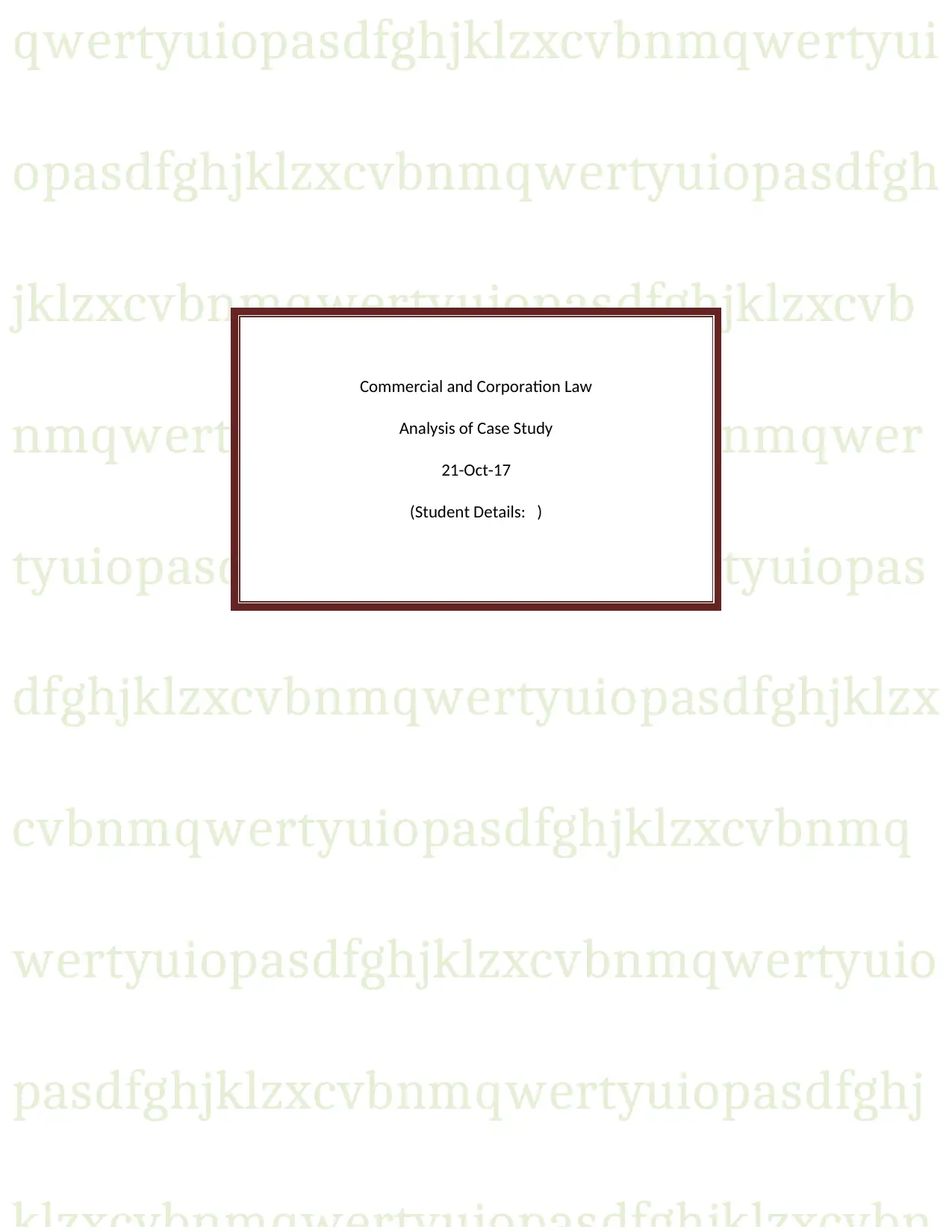
qwertyuiopasdfghjklzxcvbnmqwertyui
opasdfghjklzxcvbnmqwertyuiopasdfgh
jklzxcvbnmqwertyuiopasdfghjklzxcvb
nmqwertyuiopasdfghjklzxcvbnmqwer
tyuiopasdfghjklzxcvbnmqwertyuiopas
dfghjklzxcvbnmqwertyuiopasdfghjklzx
cvbnmqwertyuiopasdfghjklzxcvbnmq
wertyuiopasdfghjklzxcvbnmqwertyuio
pasdfghjklzxcvbnmqwertyuiopasdfghj
Commercial and Corporation Law
Analysis of Case Study
21-Oct-17
(Student Details: )
opasdfghjklzxcvbnmqwertyuiopasdfgh
jklzxcvbnmqwertyuiopasdfghjklzxcvb
nmqwertyuiopasdfghjklzxcvbnmqwer
tyuiopasdfghjklzxcvbnmqwertyuiopas
dfghjklzxcvbnmqwertyuiopasdfghjklzx
cvbnmqwertyuiopasdfghjklzxcvbnmq
wertyuiopasdfghjklzxcvbnmqwertyuio
pasdfghjklzxcvbnmqwertyuiopasdfghj
Commercial and Corporation Law
Analysis of Case Study
21-Oct-17
(Student Details: )
Paraphrase This Document
Need a fresh take? Get an instant paraphrase of this document with our AI Paraphraser
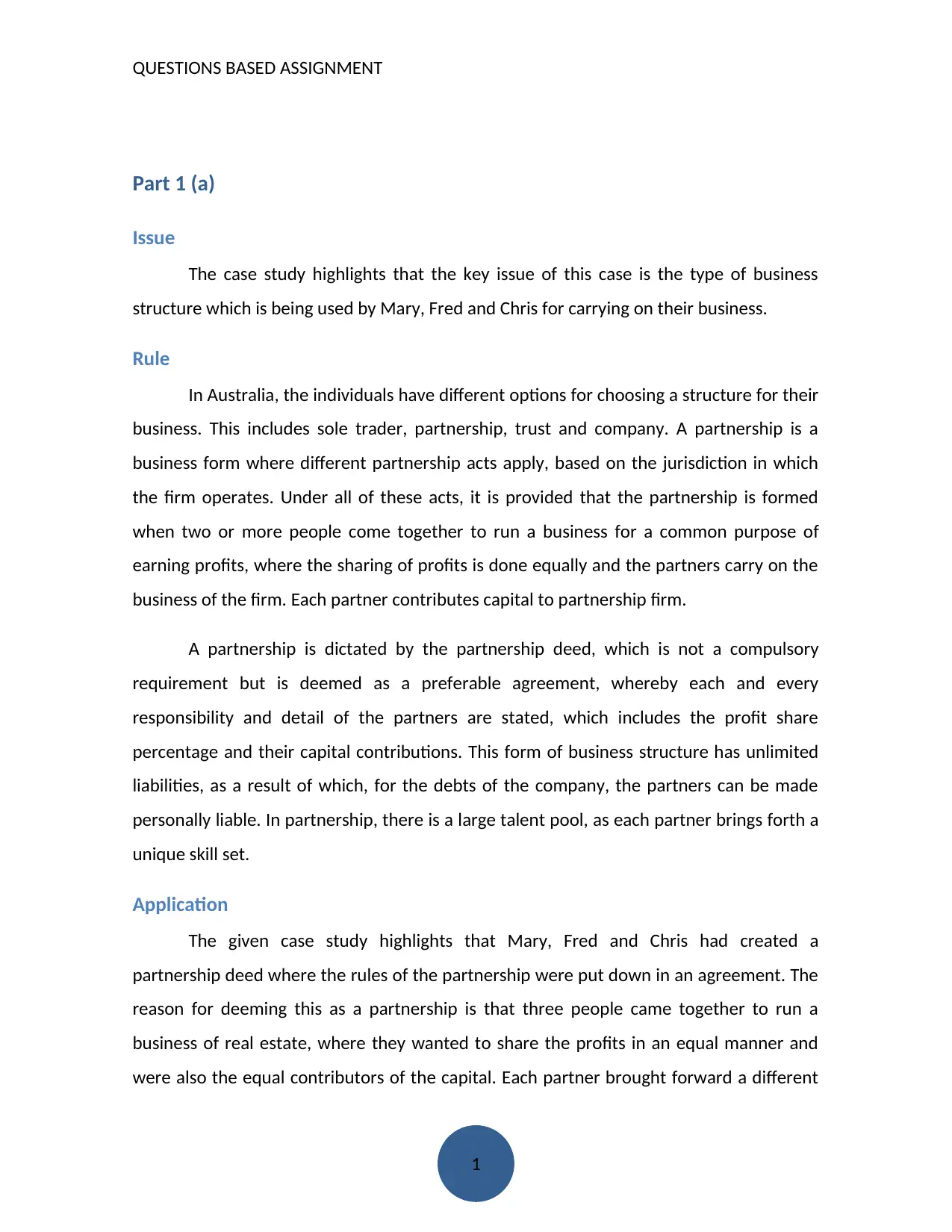
1
QUESTIONS BASED ASSIGNMENT
Part 1 (a)
Issue
The case study highlights that the key issue of this case is the type of business
structure which is being used by Mary, Fred and Chris for carrying on their business.
Rule
In Australia, the individuals have different options for choosing a structure for their
business. This includes sole trader, partnership, trust and company. A partnership is a
business form where different partnership acts apply, based on the jurisdiction in which
the firm operates. Under all of these acts, it is provided that the partnership is formed
when two or more people come together to run a business for a common purpose of
earning profits, where the sharing of profits is done equally and the partners carry on the
business of the firm. Each partner contributes capital to partnership firm.
A partnership is dictated by the partnership deed, which is not a compulsory
requirement but is deemed as a preferable agreement, whereby each and every
responsibility and detail of the partners are stated, which includes the profit share
percentage and their capital contributions. This form of business structure has unlimited
liabilities, as a result of which, for the debts of the company, the partners can be made
personally liable. In partnership, there is a large talent pool, as each partner brings forth a
unique skill set.
Application
The given case study highlights that Mary, Fred and Chris had created a
partnership deed where the rules of the partnership were put down in an agreement. The
reason for deeming this as a partnership is that three people came together to run a
business of real estate, where they wanted to share the profits in an equal manner and
were also the equal contributors of the capital. Each partner brought forward a different
QUESTIONS BASED ASSIGNMENT
Part 1 (a)
Issue
The case study highlights that the key issue of this case is the type of business
structure which is being used by Mary, Fred and Chris for carrying on their business.
Rule
In Australia, the individuals have different options for choosing a structure for their
business. This includes sole trader, partnership, trust and company. A partnership is a
business form where different partnership acts apply, based on the jurisdiction in which
the firm operates. Under all of these acts, it is provided that the partnership is formed
when two or more people come together to run a business for a common purpose of
earning profits, where the sharing of profits is done equally and the partners carry on the
business of the firm. Each partner contributes capital to partnership firm.
A partnership is dictated by the partnership deed, which is not a compulsory
requirement but is deemed as a preferable agreement, whereby each and every
responsibility and detail of the partners are stated, which includes the profit share
percentage and their capital contributions. This form of business structure has unlimited
liabilities, as a result of which, for the debts of the company, the partners can be made
personally liable. In partnership, there is a large talent pool, as each partner brings forth a
unique skill set.
Application
The given case study highlights that Mary, Fred and Chris had created a
partnership deed where the rules of the partnership were put down in an agreement. The
reason for deeming this as a partnership is that three people came together to run a
business of real estate, where they wanted to share the profits in an equal manner and
were also the equal contributors of the capital. Each partner brought forward a different
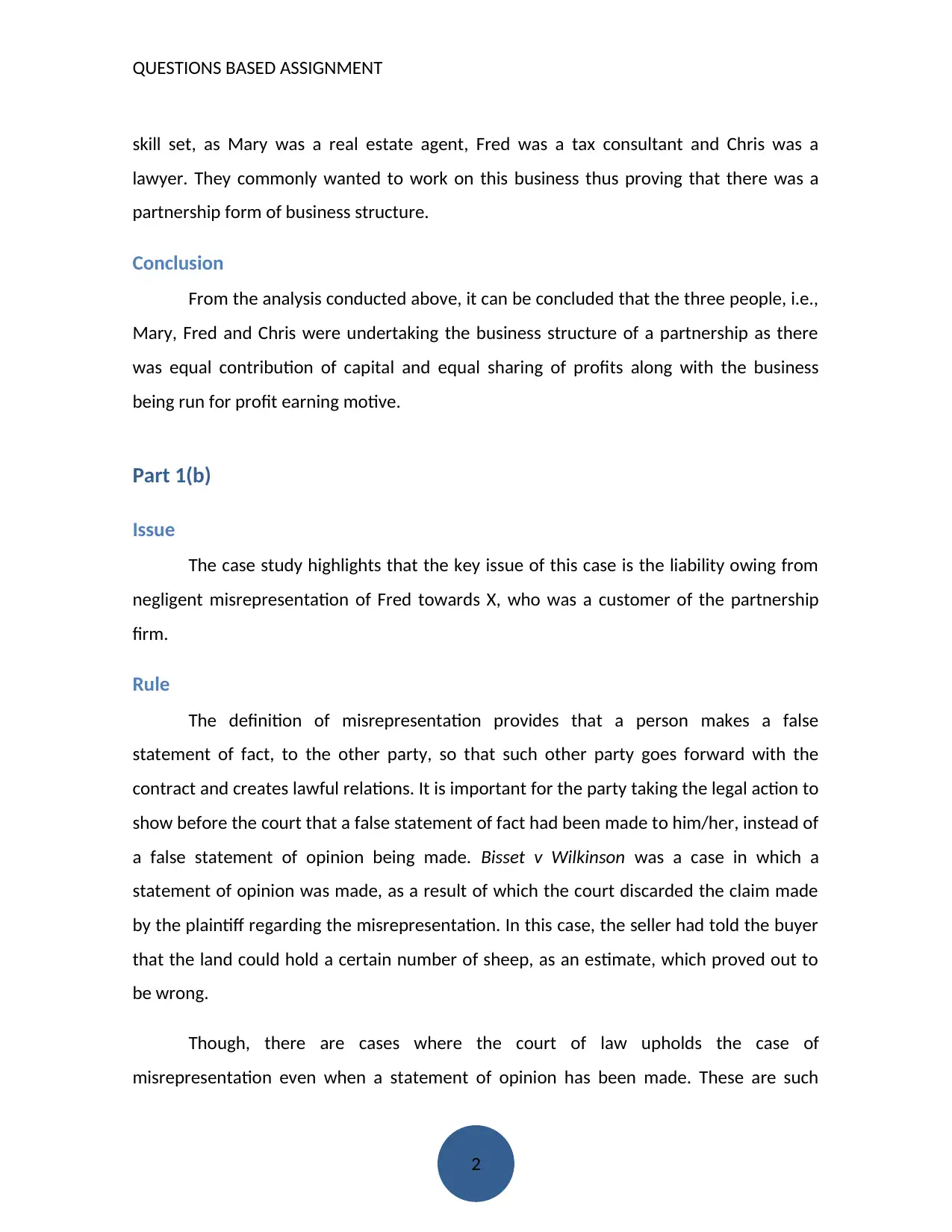
2
QUESTIONS BASED ASSIGNMENT
skill set, as Mary was a real estate agent, Fred was a tax consultant and Chris was a
lawyer. They commonly wanted to work on this business thus proving that there was a
partnership form of business structure.
Conclusion
From the analysis conducted above, it can be concluded that the three people, i.e.,
Mary, Fred and Chris were undertaking the business structure of a partnership as there
was equal contribution of capital and equal sharing of profits along with the business
being run for profit earning motive.
Part 1(b)
Issue
The case study highlights that the key issue of this case is the liability owing from
negligent misrepresentation of Fred towards X, who was a customer of the partnership
firm.
Rule
The definition of misrepresentation provides that a person makes a false
statement of fact, to the other party, so that such other party goes forward with the
contract and creates lawful relations. It is important for the party taking the legal action to
show before the court that a false statement of fact had been made to him/her, instead of
a false statement of opinion being made. Bisset v Wilkinson was a case in which a
statement of opinion was made, as a result of which the court discarded the claim made
by the plaintiff regarding the misrepresentation. In this case, the seller had told the buyer
that the land could hold a certain number of sheep, as an estimate, which proved out to
be wrong.
Though, there are cases where the court of law upholds the case of
misrepresentation even when a statement of opinion has been made. These are such
QUESTIONS BASED ASSIGNMENT
skill set, as Mary was a real estate agent, Fred was a tax consultant and Chris was a
lawyer. They commonly wanted to work on this business thus proving that there was a
partnership form of business structure.
Conclusion
From the analysis conducted above, it can be concluded that the three people, i.e.,
Mary, Fred and Chris were undertaking the business structure of a partnership as there
was equal contribution of capital and equal sharing of profits along with the business
being run for profit earning motive.
Part 1(b)
Issue
The case study highlights that the key issue of this case is the liability owing from
negligent misrepresentation of Fred towards X, who was a customer of the partnership
firm.
Rule
The definition of misrepresentation provides that a person makes a false
statement of fact, to the other party, so that such other party goes forward with the
contract and creates lawful relations. It is important for the party taking the legal action to
show before the court that a false statement of fact had been made to him/her, instead of
a false statement of opinion being made. Bisset v Wilkinson was a case in which a
statement of opinion was made, as a result of which the court discarded the claim made
by the plaintiff regarding the misrepresentation. In this case, the seller had told the buyer
that the land could hold a certain number of sheep, as an estimate, which proved out to
be wrong.
Though, there are cases where the court of law upholds the case of
misrepresentation even when a statement of opinion has been made. These are such
⊘ This is a preview!⊘
Do you want full access?
Subscribe today to unlock all pages.

Trusted by 1+ million students worldwide
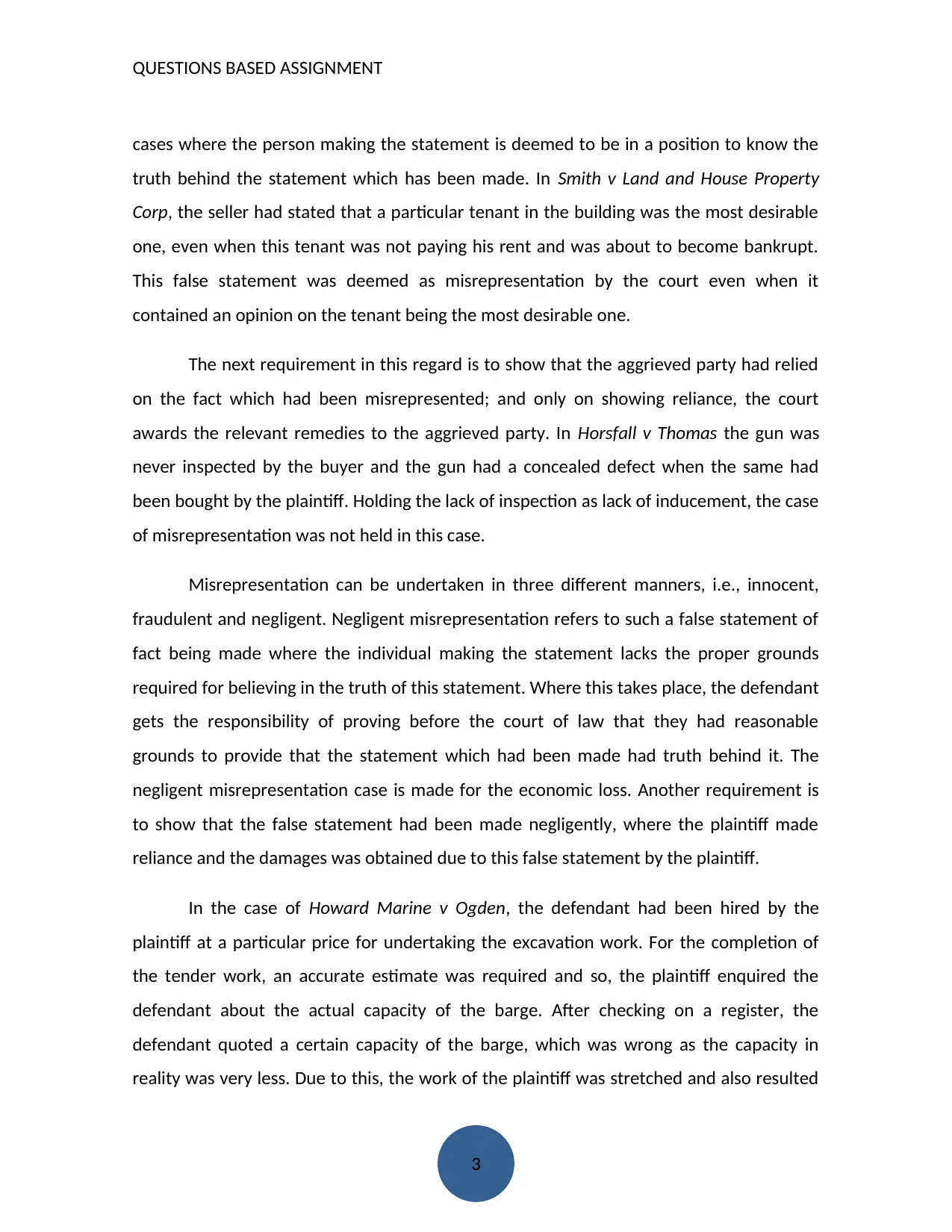
3
QUESTIONS BASED ASSIGNMENT
cases where the person making the statement is deemed to be in a position to know the
truth behind the statement which has been made. In Smith v Land and House Property
Corp, the seller had stated that a particular tenant in the building was the most desirable
one, even when this tenant was not paying his rent and was about to become bankrupt.
This false statement was deemed as misrepresentation by the court even when it
contained an opinion on the tenant being the most desirable one.
The next requirement in this regard is to show that the aggrieved party had relied
on the fact which had been misrepresented; and only on showing reliance, the court
awards the relevant remedies to the aggrieved party. In Horsfall v Thomas the gun was
never inspected by the buyer and the gun had a concealed defect when the same had
been bought by the plaintiff. Holding the lack of inspection as lack of inducement, the case
of misrepresentation was not held in this case.
Misrepresentation can be undertaken in three different manners, i.e., innocent,
fraudulent and negligent. Negligent misrepresentation refers to such a false statement of
fact being made where the individual making the statement lacks the proper grounds
required for believing in the truth of this statement. Where this takes place, the defendant
gets the responsibility of proving before the court of law that they had reasonable
grounds to provide that the statement which had been made had truth behind it. The
negligent misrepresentation case is made for the economic loss. Another requirement is
to show that the false statement had been made negligently, where the plaintiff made
reliance and the damages was obtained due to this false statement by the plaintiff.
In the case of Howard Marine v Ogden, the defendant had been hired by the
plaintiff at a particular price for undertaking the excavation work. For the completion of
the tender work, an accurate estimate was required and so, the plaintiff enquired the
defendant about the actual capacity of the barge. After checking on a register, the
defendant quoted a certain capacity of the barge, which was wrong as the capacity in
reality was very less. Due to this, the work of the plaintiff was stretched and also resulted
QUESTIONS BASED ASSIGNMENT
cases where the person making the statement is deemed to be in a position to know the
truth behind the statement which has been made. In Smith v Land and House Property
Corp, the seller had stated that a particular tenant in the building was the most desirable
one, even when this tenant was not paying his rent and was about to become bankrupt.
This false statement was deemed as misrepresentation by the court even when it
contained an opinion on the tenant being the most desirable one.
The next requirement in this regard is to show that the aggrieved party had relied
on the fact which had been misrepresented; and only on showing reliance, the court
awards the relevant remedies to the aggrieved party. In Horsfall v Thomas the gun was
never inspected by the buyer and the gun had a concealed defect when the same had
been bought by the plaintiff. Holding the lack of inspection as lack of inducement, the case
of misrepresentation was not held in this case.
Misrepresentation can be undertaken in three different manners, i.e., innocent,
fraudulent and negligent. Negligent misrepresentation refers to such a false statement of
fact being made where the individual making the statement lacks the proper grounds
required for believing in the truth of this statement. Where this takes place, the defendant
gets the responsibility of proving before the court of law that they had reasonable
grounds to provide that the statement which had been made had truth behind it. The
negligent misrepresentation case is made for the economic loss. Another requirement is
to show that the false statement had been made negligently, where the plaintiff made
reliance and the damages was obtained due to this false statement by the plaintiff.
In the case of Howard Marine v Ogden, the defendant had been hired by the
plaintiff at a particular price for undertaking the excavation work. For the completion of
the tender work, an accurate estimate was required and so, the plaintiff enquired the
defendant about the actual capacity of the barge. After checking on a register, the
defendant quoted a certain capacity of the barge, which was wrong as the capacity in
reality was very less. Due to this, the work of the plaintiff was stretched and also resulted
Paraphrase This Document
Need a fresh take? Get an instant paraphrase of this document with our AI Paraphraser
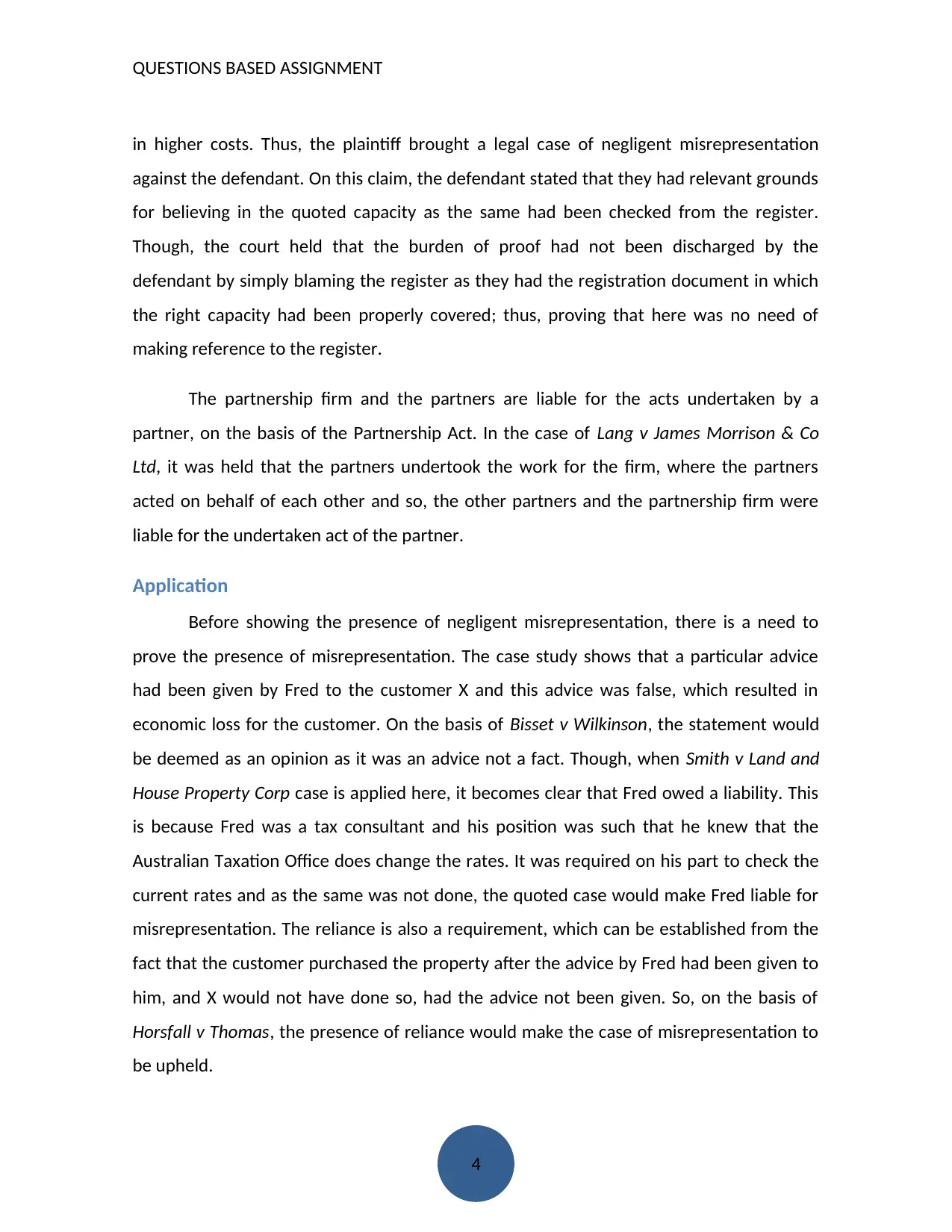
4
QUESTIONS BASED ASSIGNMENT
in higher costs. Thus, the plaintiff brought a legal case of negligent misrepresentation
against the defendant. On this claim, the defendant stated that they had relevant grounds
for believing in the quoted capacity as the same had been checked from the register.
Though, the court held that the burden of proof had not been discharged by the
defendant by simply blaming the register as they had the registration document in which
the right capacity had been properly covered; thus, proving that here was no need of
making reference to the register.
The partnership firm and the partners are liable for the acts undertaken by a
partner, on the basis of the Partnership Act. In the case of Lang v James Morrison & Co
Ltd, it was held that the partners undertook the work for the firm, where the partners
acted on behalf of each other and so, the other partners and the partnership firm were
liable for the undertaken act of the partner.
Application
Before showing the presence of negligent misrepresentation, there is a need to
prove the presence of misrepresentation. The case study shows that a particular advice
had been given by Fred to the customer X and this advice was false, which resulted in
economic loss for the customer. On the basis of Bisset v Wilkinson, the statement would
be deemed as an opinion as it was an advice not a fact. Though, when Smith v Land and
House Property Corp case is applied here, it becomes clear that Fred owed a liability. This
is because Fred was a tax consultant and his position was such that he knew that the
Australian Taxation Office does change the rates. It was required on his part to check the
current rates and as the same was not done, the quoted case would make Fred liable for
misrepresentation. The reliance is also a requirement, which can be established from the
fact that the customer purchased the property after the advice by Fred had been given to
him, and X would not have done so, had the advice not been given. So, on the basis of
Horsfall v Thomas, the presence of reliance would make the case of misrepresentation to
be upheld.
QUESTIONS BASED ASSIGNMENT
in higher costs. Thus, the plaintiff brought a legal case of negligent misrepresentation
against the defendant. On this claim, the defendant stated that they had relevant grounds
for believing in the quoted capacity as the same had been checked from the register.
Though, the court held that the burden of proof had not been discharged by the
defendant by simply blaming the register as they had the registration document in which
the right capacity had been properly covered; thus, proving that here was no need of
making reference to the register.
The partnership firm and the partners are liable for the acts undertaken by a
partner, on the basis of the Partnership Act. In the case of Lang v James Morrison & Co
Ltd, it was held that the partners undertook the work for the firm, where the partners
acted on behalf of each other and so, the other partners and the partnership firm were
liable for the undertaken act of the partner.
Application
Before showing the presence of negligent misrepresentation, there is a need to
prove the presence of misrepresentation. The case study shows that a particular advice
had been given by Fred to the customer X and this advice was false, which resulted in
economic loss for the customer. On the basis of Bisset v Wilkinson, the statement would
be deemed as an opinion as it was an advice not a fact. Though, when Smith v Land and
House Property Corp case is applied here, it becomes clear that Fred owed a liability. This
is because Fred was a tax consultant and his position was such that he knew that the
Australian Taxation Office does change the rates. It was required on his part to check the
current rates and as the same was not done, the quoted case would make Fred liable for
misrepresentation. The reliance is also a requirement, which can be established from the
fact that the customer purchased the property after the advice by Fred had been given to
him, and X would not have done so, had the advice not been given. So, on the basis of
Horsfall v Thomas, the presence of reliance would make the case of misrepresentation to
be upheld.

5
QUESTIONS BASED ASSIGNMENT
Now the requirement is to show that misrepresentation was undertaken in a
negligent manner. Fred failed to check the current rates for the advice being given to X
being a reliable one. And an economic loss was caused to X which fulfils the requirements
of making a case of negligent misrepresentation. Further, on the basis of Howard Marine v
Ogden, giving an estimate without cross referencing the current rate would further affirm
the presence of negligent misrepresentation. And on the basis of Lang v James Morrison &
Co Ltd, Mary and Chris would be liable for this negligent misrepresentation.
Conclusion
From the analysis conducted above, it can be concluded that a case of negligent
misrepresentation was present against Fred and this allows consumer X to bring forward a
case against Fred and the remaining two partners.
Part 1(c)
Issue
The case study highlights that the key issue of this case is the liability of Fred and
the business partners towards the advice which was forwarded by X to Y.
Rule
A partner can be made responsible towards the actions undertaken by the other
partners. Though, the liability is raised only when the same is raised under the scope of
authority which is given to the partners. In National Commercial Banking Corporation of
Australia Ltd v Batty it was held by the court that the partnership firm could not be held
accountable for the partner’s actions since the actions were undertaken in a wrongful
manner, where the scope of authority was exceeded. Similarly, in Mercantile Credit Co Ltd
v Garrod, the liability of the partners were held towards the other partners of a
partnership firm, for the acts undertaken by the partner, in their scope of authority.
QUESTIONS BASED ASSIGNMENT
Now the requirement is to show that misrepresentation was undertaken in a
negligent manner. Fred failed to check the current rates for the advice being given to X
being a reliable one. And an economic loss was caused to X which fulfils the requirements
of making a case of negligent misrepresentation. Further, on the basis of Howard Marine v
Ogden, giving an estimate without cross referencing the current rate would further affirm
the presence of negligent misrepresentation. And on the basis of Lang v James Morrison &
Co Ltd, Mary and Chris would be liable for this negligent misrepresentation.
Conclusion
From the analysis conducted above, it can be concluded that a case of negligent
misrepresentation was present against Fred and this allows consumer X to bring forward a
case against Fred and the remaining two partners.
Part 1(c)
Issue
The case study highlights that the key issue of this case is the liability of Fred and
the business partners towards the advice which was forwarded by X to Y.
Rule
A partner can be made responsible towards the actions undertaken by the other
partners. Though, the liability is raised only when the same is raised under the scope of
authority which is given to the partners. In National Commercial Banking Corporation of
Australia Ltd v Batty it was held by the court that the partnership firm could not be held
accountable for the partner’s actions since the actions were undertaken in a wrongful
manner, where the scope of authority was exceeded. Similarly, in Mercantile Credit Co Ltd
v Garrod, the liability of the partners were held towards the other partners of a
partnership firm, for the acts undertaken by the partner, in their scope of authority.
⊘ This is a preview!⊘
Do you want full access?
Subscribe today to unlock all pages.

Trusted by 1+ million students worldwide
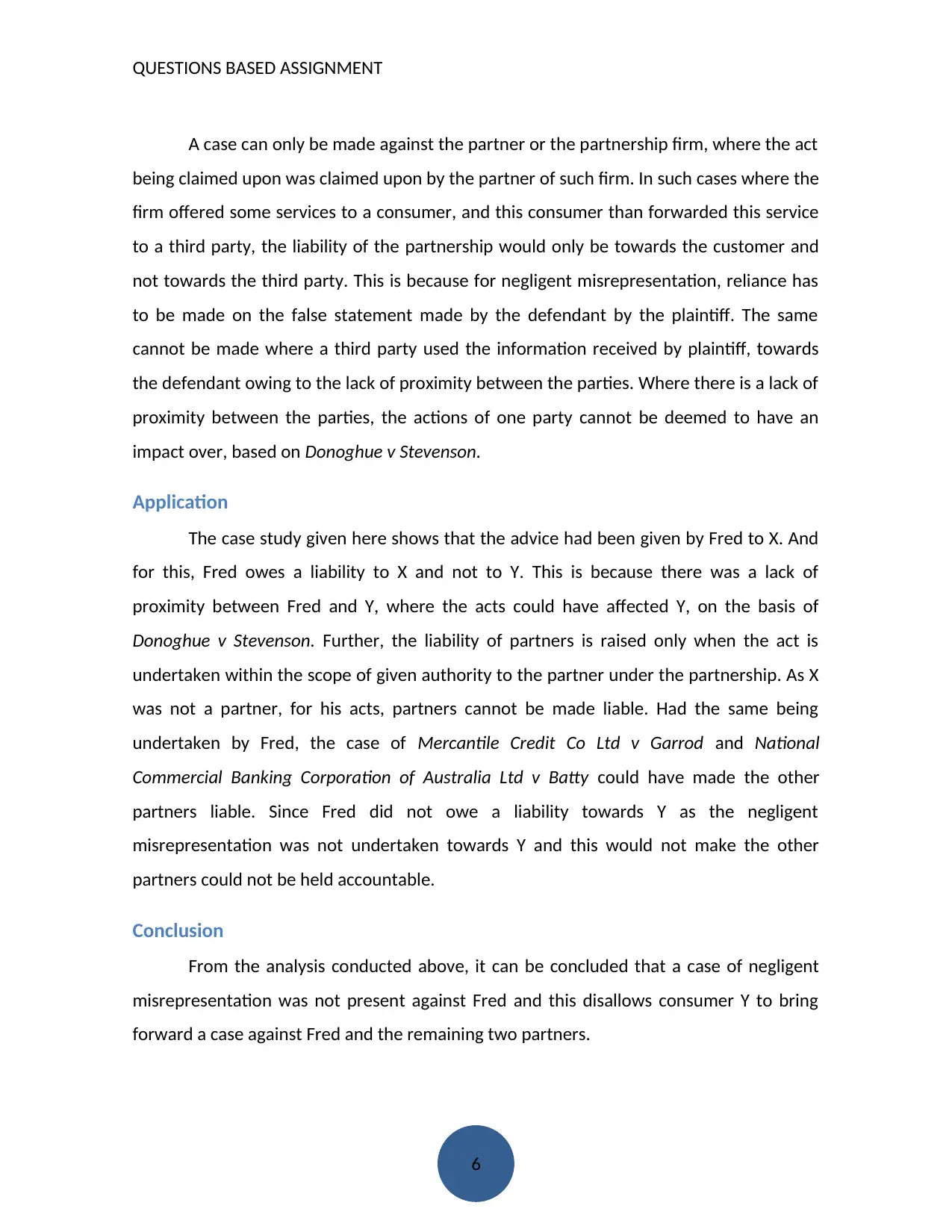
6
QUESTIONS BASED ASSIGNMENT
A case can only be made against the partner or the partnership firm, where the act
being claimed upon was claimed upon by the partner of such firm. In such cases where the
firm offered some services to a consumer, and this consumer than forwarded this service
to a third party, the liability of the partnership would only be towards the customer and
not towards the third party. This is because for negligent misrepresentation, reliance has
to be made on the false statement made by the defendant by the plaintiff. The same
cannot be made where a third party used the information received by plaintiff, towards
the defendant owing to the lack of proximity between the parties. Where there is a lack of
proximity between the parties, the actions of one party cannot be deemed to have an
impact over, based on Donoghue v Stevenson.
Application
The case study given here shows that the advice had been given by Fred to X. And
for this, Fred owes a liability to X and not to Y. This is because there was a lack of
proximity between Fred and Y, where the acts could have affected Y, on the basis of
Donoghue v Stevenson. Further, the liability of partners is raised only when the act is
undertaken within the scope of given authority to the partner under the partnership. As X
was not a partner, for his acts, partners cannot be made liable. Had the same being
undertaken by Fred, the case of Mercantile Credit Co Ltd v Garrod and National
Commercial Banking Corporation of Australia Ltd v Batty could have made the other
partners liable. Since Fred did not owe a liability towards Y as the negligent
misrepresentation was not undertaken towards Y and this would not make the other
partners could not be held accountable.
Conclusion
From the analysis conducted above, it can be concluded that a case of negligent
misrepresentation was not present against Fred and this disallows consumer Y to bring
forward a case against Fred and the remaining two partners.
QUESTIONS BASED ASSIGNMENT
A case can only be made against the partner or the partnership firm, where the act
being claimed upon was claimed upon by the partner of such firm. In such cases where the
firm offered some services to a consumer, and this consumer than forwarded this service
to a third party, the liability of the partnership would only be towards the customer and
not towards the third party. This is because for negligent misrepresentation, reliance has
to be made on the false statement made by the defendant by the plaintiff. The same
cannot be made where a third party used the information received by plaintiff, towards
the defendant owing to the lack of proximity between the parties. Where there is a lack of
proximity between the parties, the actions of one party cannot be deemed to have an
impact over, based on Donoghue v Stevenson.
Application
The case study given here shows that the advice had been given by Fred to X. And
for this, Fred owes a liability to X and not to Y. This is because there was a lack of
proximity between Fred and Y, where the acts could have affected Y, on the basis of
Donoghue v Stevenson. Further, the liability of partners is raised only when the act is
undertaken within the scope of given authority to the partner under the partnership. As X
was not a partner, for his acts, partners cannot be made liable. Had the same being
undertaken by Fred, the case of Mercantile Credit Co Ltd v Garrod and National
Commercial Banking Corporation of Australia Ltd v Batty could have made the other
partners liable. Since Fred did not owe a liability towards Y as the negligent
misrepresentation was not undertaken towards Y and this would not make the other
partners could not be held accountable.
Conclusion
From the analysis conducted above, it can be concluded that a case of negligent
misrepresentation was not present against Fred and this disallows consumer Y to bring
forward a case against Fred and the remaining two partners.
Paraphrase This Document
Need a fresh take? Get an instant paraphrase of this document with our AI Paraphraser

7
QUESTIONS BASED ASSIGNMENT
Part 2(a)
Issue
The case study highlights that the key issue of this case is the business structure
which Mary, Fred and Chris should now opt for.
Rule
As has been stated earlier, company is amongst the choices of business structure
which can be opted in the nation. Company is given the status of being an artificial person
and a separate legal entity, as a result of which, the company has the power of making
contracts in its own name, buying or selling properties and to do any other thing which is
permissible to a person. The concept of separate legal entity means that the persons who
run the business of the company are not liable for the debts of the company, giving them
limited liability, as opposed to a partnership form of business. So, the liability of
shareholders is restricted to the amount of unpaid share capital. The shares of company
can be easily transferred, whereas in a partnership, the transfer of profit percentage
requires consent of all the partners. Also, unlike a partnership, the company is free to
raise capital. Further, when a new director or shareholder is added to the company, there
is no need to revalue the company, which is a requirement for when a new partner is
added in a partnership firm.
The Corporations Act is applicable in the nation over the company, which brings
forward the provisions of director duties, incorporation of company, its winding up, and
naming of the company, amongst the other things. Based on the choice of the people
opting for this business form, the type of company can be elected. This choice is of
particular significance as the category from which the capital can be raised, is restricted on
it. When a public company is opted for, the capital can be raised from general public;
however, when a proprietary form of business structure is opted, the capital can only be
QUESTIONS BASED ASSIGNMENT
Part 2(a)
Issue
The case study highlights that the key issue of this case is the business structure
which Mary, Fred and Chris should now opt for.
Rule
As has been stated earlier, company is amongst the choices of business structure
which can be opted in the nation. Company is given the status of being an artificial person
and a separate legal entity, as a result of which, the company has the power of making
contracts in its own name, buying or selling properties and to do any other thing which is
permissible to a person. The concept of separate legal entity means that the persons who
run the business of the company are not liable for the debts of the company, giving them
limited liability, as opposed to a partnership form of business. So, the liability of
shareholders is restricted to the amount of unpaid share capital. The shares of company
can be easily transferred, whereas in a partnership, the transfer of profit percentage
requires consent of all the partners. Also, unlike a partnership, the company is free to
raise capital. Further, when a new director or shareholder is added to the company, there
is no need to revalue the company, which is a requirement for when a new partner is
added in a partnership firm.
The Corporations Act is applicable in the nation over the company, which brings
forward the provisions of director duties, incorporation of company, its winding up, and
naming of the company, amongst the other things. Based on the choice of the people
opting for this business form, the type of company can be elected. This choice is of
particular significance as the category from which the capital can be raised, is restricted on
it. When a public company is opted for, the capital can be raised from general public;
however, when a proprietary form of business structure is opted, the capital can only be
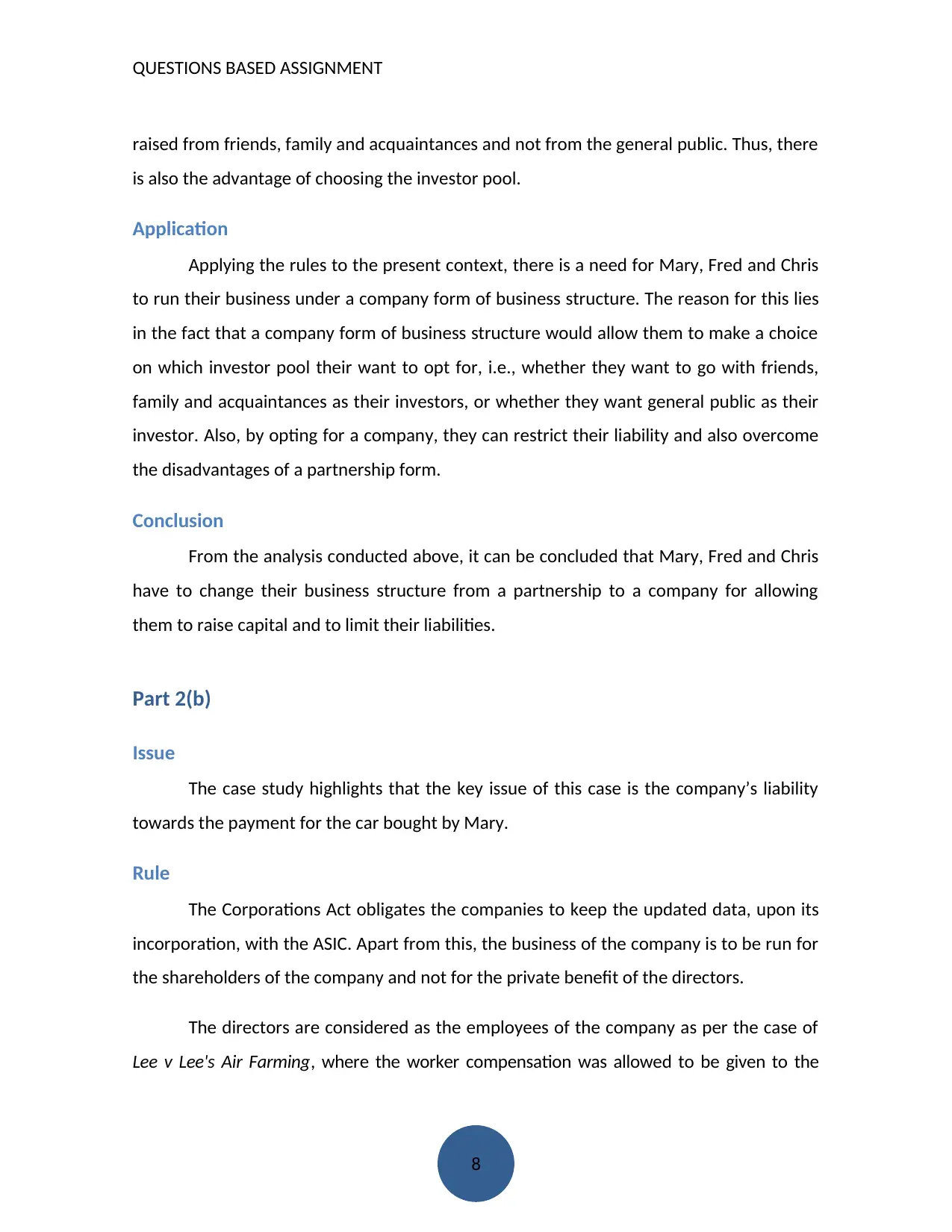
8
QUESTIONS BASED ASSIGNMENT
raised from friends, family and acquaintances and not from the general public. Thus, there
is also the advantage of choosing the investor pool.
Application
Applying the rules to the present context, there is a need for Mary, Fred and Chris
to run their business under a company form of business structure. The reason for this lies
in the fact that a company form of business structure would allow them to make a choice
on which investor pool their want to opt for, i.e., whether they want to go with friends,
family and acquaintances as their investors, or whether they want general public as their
investor. Also, by opting for a company, they can restrict their liability and also overcome
the disadvantages of a partnership form.
Conclusion
From the analysis conducted above, it can be concluded that Mary, Fred and Chris
have to change their business structure from a partnership to a company for allowing
them to raise capital and to limit their liabilities.
Part 2(b)
Issue
The case study highlights that the key issue of this case is the company’s liability
towards the payment for the car bought by Mary.
Rule
The Corporations Act obligates the companies to keep the updated data, upon its
incorporation, with the ASIC. Apart from this, the business of the company is to be run for
the shareholders of the company and not for the private benefit of the directors.
The directors are considered as the employees of the company as per the case of
Lee v Lee's Air Farming, where the worker compensation was allowed to be given to the
QUESTIONS BASED ASSIGNMENT
raised from friends, family and acquaintances and not from the general public. Thus, there
is also the advantage of choosing the investor pool.
Application
Applying the rules to the present context, there is a need for Mary, Fred and Chris
to run their business under a company form of business structure. The reason for this lies
in the fact that a company form of business structure would allow them to make a choice
on which investor pool their want to opt for, i.e., whether they want to go with friends,
family and acquaintances as their investors, or whether they want general public as their
investor. Also, by opting for a company, they can restrict their liability and also overcome
the disadvantages of a partnership form.
Conclusion
From the analysis conducted above, it can be concluded that Mary, Fred and Chris
have to change their business structure from a partnership to a company for allowing
them to raise capital and to limit their liabilities.
Part 2(b)
Issue
The case study highlights that the key issue of this case is the company’s liability
towards the payment for the car bought by Mary.
Rule
The Corporations Act obligates the companies to keep the updated data, upon its
incorporation, with the ASIC. Apart from this, the business of the company is to be run for
the shareholders of the company and not for the private benefit of the directors.
The directors are considered as the employees of the company as per the case of
Lee v Lee's Air Farming, where the worker compensation was allowed to be given to the
⊘ This is a preview!⊘
Do you want full access?
Subscribe today to unlock all pages.

Trusted by 1+ million students worldwide
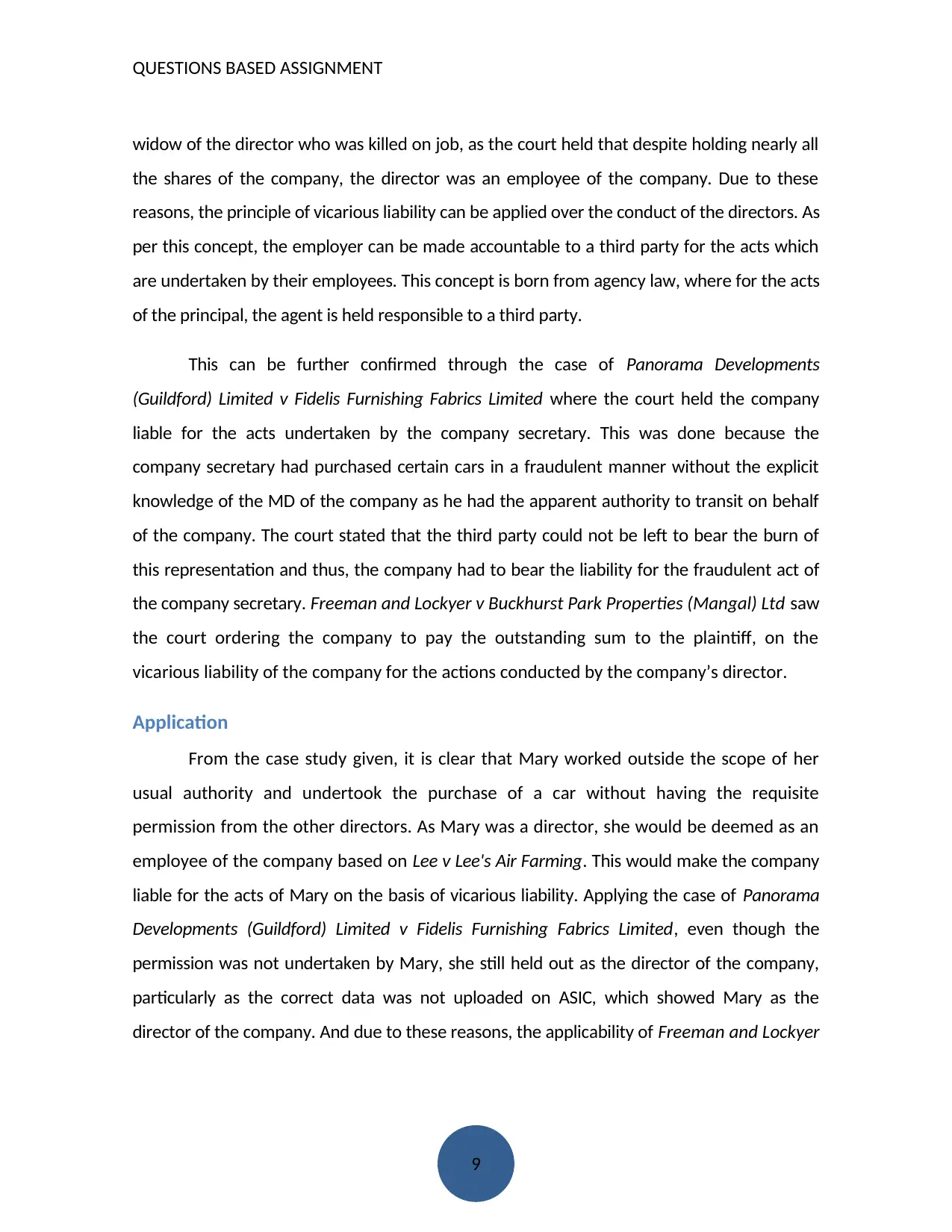
9
QUESTIONS BASED ASSIGNMENT
widow of the director who was killed on job, as the court held that despite holding nearly all
the shares of the company, the director was an employee of the company. Due to these
reasons, the principle of vicarious liability can be applied over the conduct of the directors. As
per this concept, the employer can be made accountable to a third party for the acts which
are undertaken by their employees. This concept is born from agency law, where for the acts
of the principal, the agent is held responsible to a third party.
This can be further confirmed through the case of Panorama Developments
(Guildford) Limited v Fidelis Furnishing Fabrics Limited where the court held the company
liable for the acts undertaken by the company secretary. This was done because the
company secretary had purchased certain cars in a fraudulent manner without the explicit
knowledge of the MD of the company as he had the apparent authority to transit on behalf
of the company. The court stated that the third party could not be left to bear the burn of
this representation and thus, the company had to bear the liability for the fraudulent act of
the company secretary. Freeman and Lockyer v Buckhurst Park Properties (Mangal) Ltd saw
the court ordering the company to pay the outstanding sum to the plaintiff, on the
vicarious liability of the company for the actions conducted by the company’s director.
Application
From the case study given, it is clear that Mary worked outside the scope of her
usual authority and undertook the purchase of a car without having the requisite
permission from the other directors. As Mary was a director, she would be deemed as an
employee of the company based on Lee v Lee's Air Farming. This would make the company
liable for the acts of Mary on the basis of vicarious liability. Applying the case of Panorama
Developments (Guildford) Limited v Fidelis Furnishing Fabrics Limited, even though the
permission was not undertaken by Mary, she still held out as the director of the company,
particularly as the correct data was not uploaded on ASIC, which showed Mary as the
director of the company. And due to these reasons, the applicability of Freeman and Lockyer
QUESTIONS BASED ASSIGNMENT
widow of the director who was killed on job, as the court held that despite holding nearly all
the shares of the company, the director was an employee of the company. Due to these
reasons, the principle of vicarious liability can be applied over the conduct of the directors. As
per this concept, the employer can be made accountable to a third party for the acts which
are undertaken by their employees. This concept is born from agency law, where for the acts
of the principal, the agent is held responsible to a third party.
This can be further confirmed through the case of Panorama Developments
(Guildford) Limited v Fidelis Furnishing Fabrics Limited where the court held the company
liable for the acts undertaken by the company secretary. This was done because the
company secretary had purchased certain cars in a fraudulent manner without the explicit
knowledge of the MD of the company as he had the apparent authority to transit on behalf
of the company. The court stated that the third party could not be left to bear the burn of
this representation and thus, the company had to bear the liability for the fraudulent act of
the company secretary. Freeman and Lockyer v Buckhurst Park Properties (Mangal) Ltd saw
the court ordering the company to pay the outstanding sum to the plaintiff, on the
vicarious liability of the company for the actions conducted by the company’s director.
Application
From the case study given, it is clear that Mary worked outside the scope of her
usual authority and undertook the purchase of a car without having the requisite
permission from the other directors. As Mary was a director, she would be deemed as an
employee of the company based on Lee v Lee's Air Farming. This would make the company
liable for the acts of Mary on the basis of vicarious liability. Applying the case of Panorama
Developments (Guildford) Limited v Fidelis Furnishing Fabrics Limited, even though the
permission was not undertaken by Mary, she still held out as the director of the company,
particularly as the correct data was not uploaded on ASIC, which showed Mary as the
director of the company. And due to these reasons, the applicability of Freeman and Lockyer
Paraphrase This Document
Need a fresh take? Get an instant paraphrase of this document with our AI Paraphraser

10
QUESTIONS BASED ASSIGNMENT
v Buckhurst Park Properties (Mangal) Ltd would make the company liable to make the
payment for the car bought by Mary.
Conclusion
From the analysis conducted above, it can be concluded that owing to vicarious
liability and the fault of the company in keeping updated information with ASIC, the
company would have to make the payment for the car purchased by Mary.
QUESTIONS BASED ASSIGNMENT
v Buckhurst Park Properties (Mangal) Ltd would make the company liable to make the
payment for the car bought by Mary.
Conclusion
From the analysis conducted above, it can be concluded that owing to vicarious
liability and the fault of the company in keeping updated information with ASIC, the
company would have to make the payment for the car purchased by Mary.
1 out of 11
Related Documents
Your All-in-One AI-Powered Toolkit for Academic Success.
+13062052269
info@desklib.com
Available 24*7 on WhatsApp / Email
![[object Object]](/_next/static/media/star-bottom.7253800d.svg)
Unlock your academic potential
Copyright © 2020–2025 A2Z Services. All Rights Reserved. Developed and managed by ZUCOL.





